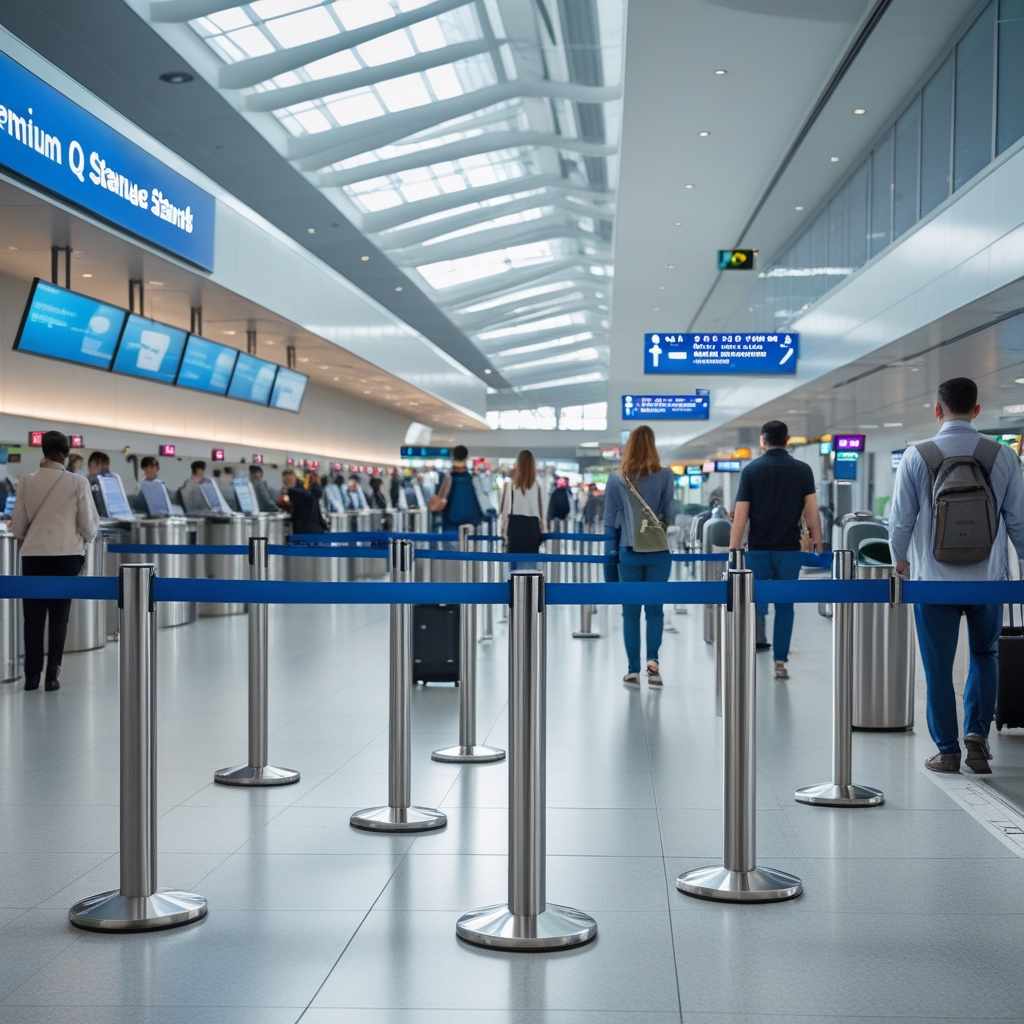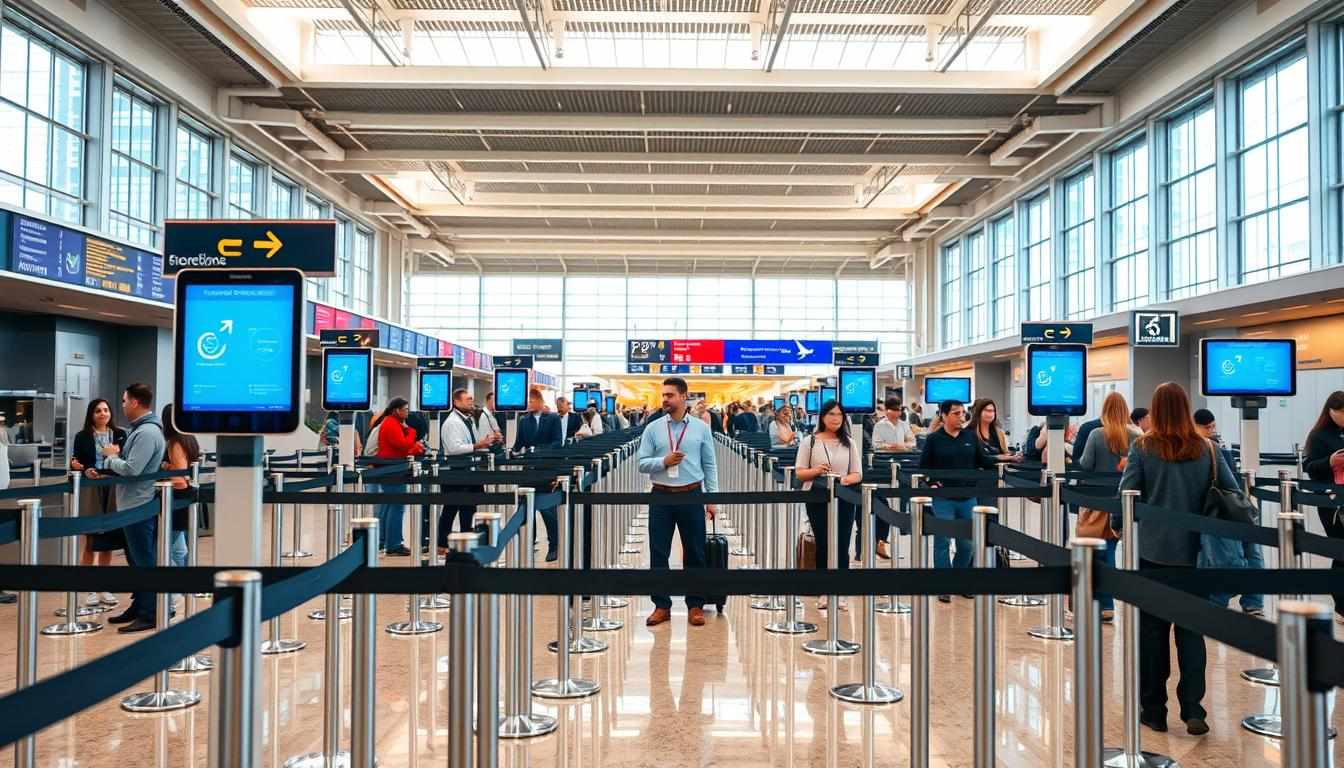
The airports become busy places that are marked by the need to have a well managed queue system at the airports that guarantees a flawless experience of the passengers. One of the units of these systems is the heavy-duty Q Stand that is capable of withstanding the burden of the high rhythm typical of high-traffic places.

Q Stand
It provides effective and consistent alternative to queue formation due to its high design aspect and of quality materials, hence, heavy duty Q Stand is not an optional component in queue operations management in any airport.
Key Takeaways
The management of the queue is important in airports.
The heavy duty Q Stands are used in high traffic locations.
Its design is rugged and the materials of high quality.
Appropriate airport queue management systems must have heavy-duty Q Stands.
They offer a solid mechanism of handling the passengers lines.
The Critical Role of Queue Management in Modern Airports
One can hardly overestimate the role of queue management in modern airports because passenger satisfaction and security processing are directly dependent on the given measure. In airports, passengers are tightly packed entities that the circulation of individuals may be quite difficult.
Passenger Flow Challenges in High-Traffic Terminals
Traditionally, high-traffic terminals have many difficulties controlling the passenger flow. Waiting and queue may create aggravation and dissatisfaction of customers. Proper queuing system plays a pivotal role in alleviating these problems.
How Effective Queue Systems Impact Customer Satisfaction
The queue systems are very crucial in increasing the customer satisfaction. Airports can ensure that the needs of the customers are addressed greatly by introducing effective queue management.
Reduced Perceived Wait Times
A decrease in perceived wait time is one of the important positive effects of good queue management. Waiting time in airports can be more bearable when they have queues organized logically and arranged in an orderly manner.
Improved Security Processing
Queue management also serves a very important role towards enhancing security processing. With a more efficient passenger conveyance system to get through the security checkpoint, the airport can ease the crowd and save on the global security.
Industry experts opine that, maintaining proper queues is not only limited to a shorter waiting time, but to making it a more enjoyable and less stressful process to the passengers.
"The way you manage your queues can significantly impact your passengers' overall experience," said an airport operations manager.
To do this, airports will be able to use a few strategies, such as:
By employing the use of clear directional signage directing the passengers throughout the terminal
Installing retractable belt that would work efficiently as queue systems
Education of the personnel to control the queues by countering it before hand
With the emphasis put on them, airports can increase customer satisfaction rates and optimize companies operations in general.
What Makes a Q Stand "Heavy Duty" for Airport Environments
In the case of airports, there is hardly such a thing as an unnecessary heavy-duty Q stand, and it is quite likely that without such a stand, walking around the airport and interacting with people would be impossible. Environmental pressures in high-traffic airports also require an airport queue management system with extreme durability as well as the ability to handle continuous work.
Premium Materials and Construction Standards
The main features that define a heavy-duty Q stand is the use of high-quality materials and being constructed to high standards. This will provide that the stand is able to hold the weight of the many passengers resting on it or the strain of the queue ropes or the belts.
Cast Iron vs. Steel Base Options
The variances between cast iron or steel that are used as the foundation of a Q stand are notable. Cast iron has admirable strength and stability hence sleek and areas of high traffic. Conversely, steel offers strength and flexibility in design and installation as well as balance between strength and weight. According to experts in the industry, the correct base material may contribute much to the overall performance and durability of Q stand.
Corrosion-Resistant Finishes
The heavy duty Q stands are generally going to be coated with a corrosion resistant coating to make sure it lasts a long period of time. They keep the metal weatherproof, and remove the corrosive influences that cleaning chemicals can have, making their stands durable and keeping the structural integrity of the metal intact in the long term.
Weight Distribution and Stability Features
Distribution of weight can be a key secure element when a Q stand is concerned. The heavy-duty ones are made in the shape of low center of gravity to avoid tipping, along with broad bases that ensure the item is not easily toppled even under considerable power. Such stability during queues is needed.
Impact and Wear Resistance in High-Traffic Areas
Q stands are subjected to wear and tear under high traffic airport locations. Impact and wear resistant heavy duty Q stands are designed with the realization of needing reinforced construction and durable material that will be able to handle the daily traffic.
With the current growth in the development of airports, the need to have strong and stable queue manager is paramount. Heavy-duty Q stand is the essential investment of any airport that aims at increasing the passenger experience and efficiency of operations.
Essential Q Stand Features for Airport Applications
The success of Q in an airport is dependent on a number of important characteristics. The features aim at maximizing the flow of passengers, safety and offering a long lasting solution to queue management.
Base Design and Anti-Toppling Technology
Tough base: Q stands should have a solid base more so in places where there is a lot of traffic. The anti-toppling technology will make the stand stable even after it has fallen due to accidents or the winds. This aspect is crucial to safety and the aversion of an accident.
Post Height Considerations for Visibility
Another factor of consideration is the height of the Q stand post. It should be able to be seen at a distance, and it should guide the passengers in the queue since it should be very tall. Unidirectional post heights are adjustable to suit according to the airport setup, whether it is at the check-in points or at the security check point.
Retractable Belt Mechanisms and Tensile Strength
Retractable belts provide flexibility and convenience because it is easy to adjust the queue line. Tensile strength of such belts is essential because they have to face continuous usage without tearing. Quality materials are fabricated in order to promote durability and reliability.
Belt Length Options
Space limitation may vary in different airports and thus adjustable belt length is a great advantage. Such flexibility enables Q stands to be interface to various queue configurations.
Braking Systems and Safety Features
In order to avoid accidents, safety covers such as braking systems are required. These mechanisms makes sure that the retractable belt is not drawn so fast that it can give someone injuries.
Conclusively, Q stands for airport applications are characterized with features that are aimed at contributing to safety, efficiency and durability. Airports can greatly enhance their queue management systems by installing anti-toppling technology, height-adjustable post and possession of sturdy retracting belts.
Types of Airport Queue Management Systems
The present-day airports utilize various queue management tools to make passengers feel better. The system should be selected depending on a number of aspects like size of the airport, the number of passengers and other operational requirement.
Traditional Post and Rope Queue Managers
They are conventional queuing tools involving stylistic use of posts and ropes to direct passengers. They are easy to place and affordable and uncomplicated.
Retractable Belt Q Stands
The solution is more advanced with the Retractable belt Q offers as it can offer a clear and ordered control of a queue. They can especially come in handy within congested places.
Electronic and Virtual Queue Management Integration
Electronic and virtual queue management systems is the contemporary method in which digital screens and intelligent tools are used to control passenger flow.
Digital Display Compatibility
Here the information can be incorporated in the digital displays where passengers will be informed in real-time.
Sensor-Equipped Smart Systems
Smart systems in which the sensors could monitor queued lengths and wait times would enable better control of passenger flow.

queue management systems
Through knowing the various kinds of queue management systems, the airports can be in the position to choose the best one regarding their needs to enhance overall efficiency and satisfaction among passengers.
Queue Manager Rope Options for Airport Settings
Identification of the queue manager ropes forms an important part of the practical design of effective queuing system at airports. The appropriate rope has the ability to increase the levels of passenger guidance, make the airport more attractive and maintain durability in the places that are mostly used by people.
Velvet Rope vs. Braided Rope Considerations
In the case of queue manager ropes, there are two common types, the velvet ropes and the braided ropes. No one can doubt the luxuriousness of velvet ropes that can be commonly found in high-end airport lounges. On the one hand, the braided ropes are more durable, and more traditional in appearances, and can be used under the heavy load.
Color Coding Strategies for Passenger Guidance
An efficient concept of color coding is applied in leading passengers through the queues at the airport. Various colors may be adopted to indicate the various queues process or to route the passengers to various locations. As an example, red ropes could be put up to show a priority queue, and blue ropes could direct the visitors towards a regular queue.
Connection Mechanisms and Quick-Release Features
Queue manager rope connecting devices and quick release aspects are very important in ease of installation and removal. Quick-release hooks allow personnel to make or break up queue lines quickly within a short time to enhance flexibility.
Hook Designs and Durability
How hooks are designed and durable when used with queue manager ropes is critical in the quest to ensure that the system is functional and safe. The design of strong hooks allows using them regularly and reduces a possibility of a rope breaking away.
Rope Length Standards
Not only are the rope lengths to be standardized, but they are also the only way to give a consistent and tidy look to the queue systems of an airport. Same length of rope also assists in making the queue management system easy to be followed by passengers.
Strategic Implementation of Q Stands in Airport Zones
These are critical as far as the Q arrangement strategy in airport areas is concerned in maximizing passengers. The challenge of handling the high presence of passengers is the situation that airports may encounter, and Q stands can be of significance in this task.
Check-in Counter Configurations
In check-in counters, Q stands support in preparation and maintenance of queues in an orderly way reducing congestion and waiting time. Effective queue management in this case establishes the atmosphere of airport experience as a whole.
Security Checkpoint Optimization
Another important place where Q stands are indispensible is the security check points. They escort the passengers through the security which ensures the management of queues and successful passage of the passengers on time to their respective gates.
Boarding Gate Queue Management
At boarding gates, Q stands are employed in controlling the queue of passengers (waiting to board their flights). This includes:
Priority Boarding Arrangements: They have dedicated queues to first-class passengers or those members of loyalty programs.
Flexible Configurations: Capacity to configure Q stand set up to meet different passenger loads and flights patterns.
Priority Boarding Setups
Priority boarding arrangements create a much smoother boarding process so that high-priority passengers do not have to wait so long.
Flexible Configurations for Variable Passenger Loads
Adjustable arrangements will also help annual airport requirements as they’ll be able to adjust to the varying quantities of passengers and everyone will have an efficient queue management exercise despite flights positioning.
Installation and Assembly Best Practices
The assembling and installing Q stand is a careful activity that must be planned thoroughly so that it can work as expected. Q stands fitted correctly are vital in the management of queues in airports.
Required Tools and Equipment
When you come to putting up your Q stand, make sure you have all the required tools and equipments. This usually comprises of a socket wrench, rubber mallet and the hardware kit of the stand. The availability of all the items will make the collection rather smooth.
Step-by-Step Assembly Process
To assemble it, read the directions of the manufacturer. This is normally:
Screwing the base on the post of the stand
Locking the retraction belt unit
Seat-belts are just attached to ensure stability
Optimal Placement Strategies for Passenger Flow
Q stands have to be placed strategically to control the flow of passengers. In what considerations:
Spacing Guidelines
Make sure that all Q stands are well spaced in order to guide passengers. Generally, they should be placed at the right intervals, that is they should not be too much, and they should be able to have a straight line of queuing.
ADA Compliance Considerations
When installing Q stands, it is necessary to adhere to the ADA requirements. This consists of leaving the path of queue accessible and putting stands where passengers with disability can be accommodated.
Installation Factor
Best Practice
Spacing
Interval between stands: 3-5 feet
ADA Compliance
Ensure accessible path, consider wheelchair turnaround
Stability
Secure base, level surface
These guidelines on installation and assembly represent the best practices that will enable the airports to have a functional Q stand to control queues and improve the experience of passengers as a whole.
Maintenance and Care for Airport Q Stands
The maintenance on the airport Q stands should include an extensive plan of periodic maintenance. Not only will regular maintenance increase the life cycle of these vital queue management systems but it will also guarantee that they keep on running within smooth conditions even in high density set up.
Daily Cleaning Protocols
Cleaning on daily basis is also a very important factor in maintenance of Q stand. Airports are well advised to introduce a regime where there is wiping of the stands in the airport using a mild detergent that removes dirt and grime. This contributes to the maintenance of look on the stands and eliminates the possibility of the accumulation of the substances which can spoil the material with time.
Belt Mechanism Maintenance Schedule
The retractable belt Q stands has an important feature, the belt mechanism. This mechanism needs regular check up and inspection so that it can smoothly retract and extend. The airport is advised to use the recommended maintenance schedule by the manufacturer that normally involves lubricating the mechanism and wear and tear inspection.
Troubleshooting Common Issues in Airport Settings
In spite of frequent maintenance, the problems may still occur. The frequent ones are belt retraction errors and changing stability of the base.
Belt Retraction Problems
In case the belt is not retracting well it might be as a result of a build up of dirt or the worn out parts. This is normally solved by cleaning the belt and the housing. There can be some instances when some worn out parts need to be replaced.
Base Stability Adjustments
It is important that the foundation of the Q stand remains stable so that the undermined stand can work altogether. In the case that the stand proves to be unbalanced, the problem can be solved by adjusting the base, as it is described in the instruction: manufacturer.
Maintenance Task
Frequency
Action Required
Daily Cleaning
Daily
Wipe down with mild detergent
Belt Mechanism Inspection
Weekly
Lubricate and inspect for wear
Base Stability Check
Monthly
Adjust base as necessary
Q Stand Maintenance
Customization Options for Airport Branding
Q stands can be customized so that they enable airports to strengthen their brand image. Airports can use these queue management systems and can brand their surroundings in a coordinated way to welcome the people who are travelling.
Logo Integration and Brand Visibility
Advertising the airports by printing their logos on the Q stands is an easy process of increasing brand exposure. This could be done in a manner of ways which includes, printing the logo on the belts or engraving names or logos on posts.
Color Matching with Airport Aesthetics
Another very important part of customization is color matching. Airports are free to select colors in accordance with its branding so that Q stands would not disrupt the design of the airport.
Custom Messaging on Belts and Posts
Customer communications can also be provided in airports through custom communications. This may comprise:
Directional signs to navigate passengers in the airport
Safety reminders to to take care of airport requirements
Directional Information
Expected directional signs allow people who travel to feel much better without confusion and stress, experiencing better travel.
Safety Instructions
Q stands could deliver safety orders to the passengers, reminding them of such safety measures as social distancing rules or mask requirements.
Customization Option
Benefit
Logo Integration
Enhanced brand visibility
Color Matching
Aesthetic consistency
Custom Messaging
Improved passenger guidance and safety
Selecting the Best Queue Manager Manufacturer
Selecting a queue manager manufacturer is a critical decision for airports, requiring consideration of several vital factors. The appropriate manufacturer may have a great influence on effectiveness and robustness of the queue management system.
Industry Experience with Airport Installations
The experience of a manufacturer in the provision of queue management systems at the airports is imperative. It also demonstrates that they know the peculiarities of the work of airports and can suggest the solution to their specific problem.
Quality Certifications and Compliance Standards
It is critical to make sure that the manufacturer has the corresponding quality certifications and that it follows the industrial specifications. This also ensures that the system of managing the queues conforms to the standards of safety and performance needed.
Customer Support and Warranty Considerations
A good customer care and warmly charmed warranty services are important in reducing the downtime and hence sustainability of the queue management system.
Replacement Parts Availability
One of the factors to consider is the replacement parts. The operators who have a re-stock of critical components can easily minimize the repair time and keep the system up and running.
Service Level Agreements
Service Level Agreements (SLAs) provide specifications on the quality of services, the time of response and resolution. An effective SLA shows the attention that a manufacturer gives to its clients and its system stability.
Manufacturer Criteria
Importance Level
Evaluation Factors
Industry Experience
High
Previous airport installations, client testimonials
Quality Certifications
High
ISO certifications, compliance with industry standards
Customer Support
Medium
Response times, support channels available
Warranty and SLAs
Medium
Duration of warranty, service level agreement terms
Conclusion: Investing in Quality for Long-Term Airport Efficiency
The reason why it is important to invest in the Q Stand of superior quality is that it will help an airport to meet consumer expectations and achieve a high level of efficiency. After recognizing the role of efficient queue management, the airports will be able to lower the time spent waiting in the lines, improve the customer experience rates, and facilitate the travel experience.
An aesthetically crafted Q Stand is an aircraft of landing but also a means of controlling the flow of passengers in the airport in addition to guiding the traffic. Airports should focus on quality and make an investment in a quality queue management system, which would help them enjoy new long-term benefits, such as increased airport efficiency and the increased satisfaction of passengers.
Airports ought to be more careful when choosing Q Stand manufacturer; varying factors to consider before deciding to use which manufacturer include industry experience, quality certifications, and customer support. This way, they will be able to make sure that their Q Stand is long-lasting, needs very little maintenance, and fits their precise requirements and needs, which will eventually make the entire airport process much more effective and less inconvenient to the passengers.
FAQ
What is a premium queue manager, and how does it differ from a standard queue manager?
A premium queue manager is a good quality system of queue management, that is applied in the high traffic regions, e.g., at airports. It is not just a normal queue manager, but it is designed with durability in mind, with high-quality materials and top-level facilities, as it has retractable belt mechanism and more compatible with digital displays.
What are the benefits of using a heavy-duty Q stand in airport settings?
Q stands are heavy duty that can withstand the test that a high traffic place presents to them and are therefore reliable and durable in queue guidance. They provide better stability, resistance to impact and wear resistance giving smooth ride to the passengers.
What types of queue management systems are available for airports?
Queuing systems available to the airports are of different varieties where we have post and rope, queue manager systems, retractions belt Q stand systems, electronic systems and virtual integration of the queue management systems. There are advantages to each system and it is a matter of individual need in an airport.
How do I choose the best queue manager manufacturer for my airport?
The industry experience with regard to its record on airport installations, quality certifications, and compliance with standards need to be borne in mind when choosing a queue manager manufacturer. In addition, seek manufacturers, who have customer support services, warranty considerations and spare parts availability.
What are the essential features of a Q stand for airport applications?
Base design and anti topple technology in a Q are essential features of an airport application since the base design is based on the collection of snow during winter. Post height is also important with regard to visibility. Post height should be enough to enhance visibility and retractable belt mechanism with tensile strength and braking system with safety standards are also features of Q necessary in airport applications.
How can I customize my airport's Q stands to align with our branding?
Airport Q stands are customizable by adding logo and exposing the brand, matching color to airport design, and printing messages on belts and posts. These alternatives are able to increase the performance of your queue application and establish a unified brand image.
What are the best practices for installing and assembling Q stands in airport settings?
The best actions when installing and constructing Q stands are to go by the book, i.e. manufacturer guideline, obey the necessary tools and facilities, and make sure that you have the best placement in line with the movement of the passengers. Take into account spacing, and ADA regulations to provide an accessible and comfortable passage to the passengers.



Write a comment ...